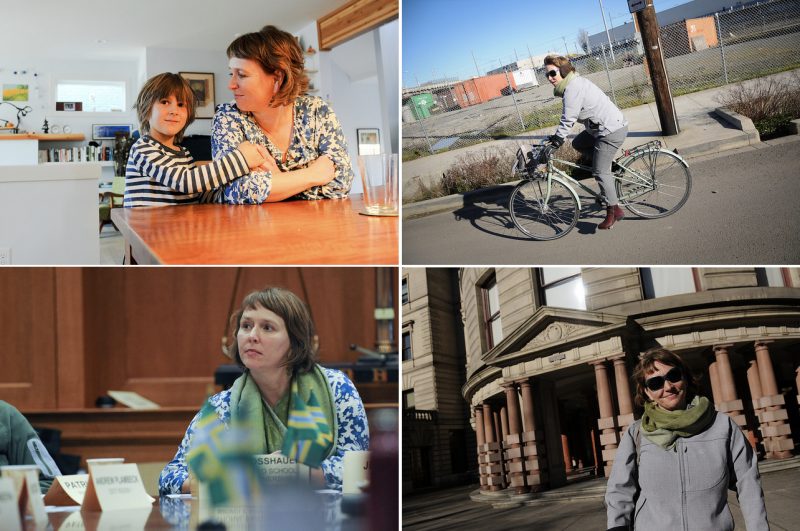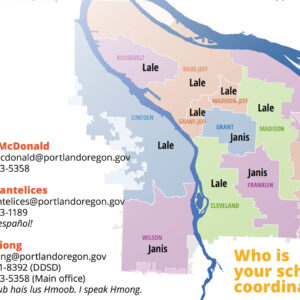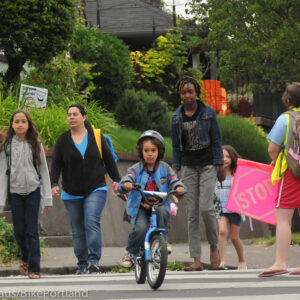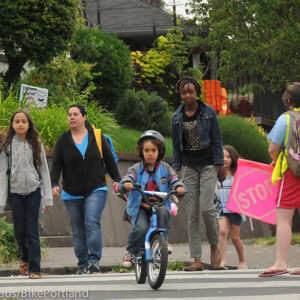
(Photos: J. Maus/BikePortland)
Even if you don’t know Kari (it rhymes with “safari”) Schlosshauer, chances are you’re familiar with her work.
As the Pacific Northwest Senior Policy Manager for the Safe Routes to School National Partnership, Schlosshauer has spent the last five years making our neighborhoods safer for walking and biking. Her position puts here at the center of discussions and deals about how and where our city, region, and state spend money for school-related transportation projects.
Schlosshauer lives in the Hosford-Abernethy neighborhood near Powell and 25th. Earlier this week I sat down with her around her kitchen table before riding downtown where she attended a meeting of the Vision Zero Task Force (she’s a member) at City Hall.
“There’s a real risk that all of that $10 million per year could go to the most well-to-do schools in the state because of some twist of how they justify the needs.”
Before we get into that conversation, here’s a bit more about her background: Before working at the Safe Routes National Partnership Schlosshauer lived in Seattle and worked as program manager for the nonprofit Cascade Bicycle Club and as field director at the Transportation Choices Coalition. After that, she moved with her husband Max (who was chasing post-doctorate research) to Australia where she worked as a project manager for the Department of Transportation in Melbourne. A few years later they moved to Copenhagen where they had their first son Eli (now eight). They moved to Portland in 2011, where their second son, Miles, was born, and Schlosshauer began working with the Safe Routes to School National Partnership in 2013 following several years off to focus on raising her two boys.
“After kids,” she shared with me when I asked how she got involved with Safe Routes, “It just made a lot of sense to focus on what would be right for them.”
Here’s the rest of our conversation (edited slightly for clarity)…
Tell us about what you do and what you’re working on right now:
“I look at the policies and funding that MPOs [Metropolitan Planning Organizations, like Metro] are picking up. I cover the Portland metro region and I also have southwest Washington and Clark County. I go to meetings and talk to elected officials to bring the perspective of the importance of health and safety for youth… and also the perspective of health equity — how certain people in our population are not getting the opportunity for the same health outcomes because of our past transportation decisions and the built environment they’ve left us with. I help get policies changed and funding connected to projects.
Right now we’re busy with rule-making and implementation [she sits on the ODOT committee creating rules to spend newly allocated Safe Routes funding]. There are a lot of communities really excited about the fact that there’s funding for street fixes and they want to know what they need to do to get that money. Even though I don’t work for the state, I get calls all the time from people asking, “What do I need to do? I really want to make this fix. What are the steps I need to take?” I also provide technical assistance to schools and cities to match them up with funding and make sure they have the resources they need to successfully apply for that money.”
How has the issue of equity changed since you’ve been doing this work?
“I think we’ve always focused on the people in most need; but we have certainly shifted over the years about being more explicit about racial equity and leading with social justice as the main priority in how we do our work.
Is there an aspect of the Safe Routes issue that people don’t expect you to bring up?
“Sometimes people are surprised to hear about the many spaces we work in: everything from street harassment to food access. It’s a stretch for some people inititally to understand why we do that much work around those issues. We also partner with AARP [American Assocation of Retired Persons] a lot because the needs of older adults and youth are very similar when it comes to traveling.”
Given the spectrum of emotions advocates go through, how are you feeling about the work in this particular moment?
“We’re coming off the tailwinds of some pretty big wins. Thanks to our partnerships, particularly with The Street Trust, in the past couple of years we’ve gotten money from Metro to pay for programs and now we’ve got infrastructure funding at the state level. Those are very big wins which set me up for shifting my focus to implementation, which is what the state rules advisory committee is all about. I want to make sure the money that was so hard-fought is actually going to the communities most in need. There’s a real risk that all of that $10 million per year could go to the most well-to-do schools in the state because of some twist of how they justify the needs. I’m trying to make sure the way the rules are written makes sure that the lowest income schools and the highest safety needs are being taken care of first.”
How has finally having money to spend changed your work?
“At the City of Portland and the state as well, there’s been a huge shift. They went from this place of total scarcity to overproduction where they have to figure out how to spend all this money. And with a lot more community members coming out of the woodwork going after the money, it’s even more important to make sure the prioritization policies that dictate where that money goes are in a good place.”
Sounds like there’s a scramble for cash. Does that create new challenges? Are our prioritization policies ready?
“The challenge is I’m not the only person at the table to try and make sure the rules are set up properly. There are a lot of people in the room. And there’s a strong voice for making sure that rural communities receive a share of the funding because there’s that perception — true or not — that Portland gets all the money. That’s a challenge. I agree that rural and small communities should receive some of this money. They have some of the worst safe routes issues. They are the communities that have a highway running through their town and it’s the main road. That’s a big issue. But my focus goes to overall, where does the money end up? Does it end up in a bunch of small but weatlthy communities with students who don’t really have that many needs? Or is it really addressing major safety concerns and reaching students who have disparate health imapcts living in low-income communities who have other issues they’re dealing with. There’s never going to be enough money for everyone; but that balance is something we’re discussing a lot.”
Advertisement
How did you end up on the Vision Zero Task Force?
“The core of Safe Routes to School is safety. That’s where it starts from. Even though our movement focuses on a lot of other issues, safey is what got this started. I think theres a natural connection to Vision Zero because it’s focused on the least safe parts of our sytem and it’s about putting people’s safey over the movement of vehicles and goods. What I see are those City of Portland maps with red roads, the barrier roads, the ones you shouldn’t be crossing as a kid, the ones that cause the school district to say, “You’re not allowed to walk anymore, we’re going to put you on a bus.” Those are the Vision Zero high crash corridors.”
What’s the biggest challenge to Safe Routes right now?
“I think in some neighborhoods those big streets are the challenge. I would say that infrastructure in general hasn’t been improved a lot in schools since the recession. It’s starting to now. There was a lot of emphasis on Safe Routes when the program first started. A lot of plans were amazing improvements around certain schools. Then the recession hit and the city ran out of money and the rest of the plans couldn’t be implemented. So for a lot of places it’s that infrastructure piece that prevents parents from letting their kids walk to school.
I also think the shift of people in Portland is interesting. Many people have gotten older or had to move because of rent or other issues and wanted to buy a house but can’t afford one in inner Portland, so they’re moving out to where the infrastructure isn’t as good. So now they’re not in that situation where they can send their kids off to school. I don’t know what it all means, but how many people are riding their bike when their route is 15 miles instead of two? What does that mean to people who used to live next to Sunnyside [a magnet school in inner southeast] and were like, “This is amazing!” And now they bought a house east of I-205 and there’s no sidewalk and they’re like, “Oh, this is not Sunnyside.” There’s a big shift there between what people perceived they could do, and what the reality is now. I don’t know what the answer is but i think we’re seeing it on our streets.”
What’s it like being a woman in this field?
“I come from the background of being a bike/ped advocate. And being a woman in that space has not always been easy. I think in my earlier days I was always more of a tough person for that reason. I feel like that has shifted for me. I think being a mom in this role has a lot of weight to it — which is great. It’s nice because I can speak from experience.
But I will definitely say that being a woman in the transportation world is difficult at times. There are definitely still people who will not talk to me. They don’t see me because I’m a woman. It happened to me just last week. They’ll walk up to a group of people — men and women — and they’ll only talk to the men. They won’t greet me, or ask me questions, or acknowledge when I say things. And that’s still a reality and that shocks me! I recognize it; but I don’t get annoyed or angry by it. I just [takes a deep breath, then exhales] you know? I can’t work with that person, I have to work extra hard with that person, or have to talk to that person’s staffer because that person won’t talk to me. That’s definitely a thing. It’s weird, but it happens still.”
You mentioned street harassment earlier. Does that come up often in your work?
“From a Safe Roputes perspective we sometimes just call that bullying and it’s what your kids would experience along the way to school whether they’re a boy or a girl. But as Safe Routes recognizes, this is not just about elementary school kids, this is about middle and high schoolers too. We’re trying to raise the next generation of people who are not getting in a car as their automatic mode of travel. In particular for middle and high schoolers — and especially for girls — it gets really difficult because they feel vulnerable when they’re getting catcalled all the time.”
So what’s the fix for that? It’s not the usual, ‘Here’s a new crosswalk, we’ll all good’ right?
“We always talk about safety in numbers; but I also think there’s an element about Safe Routes that’s about commmunity building. When this is done in a comprehensive way and it’s done well, you are really engaging the community and making it stronger. So the theory is that a stronger community would also help make some of those things go away.”
If I’m a parent that wants to make things better at my kids’ school, what can I do?
“Ask at your school if there’s already something going on. There’s so much going on at schools. If you’re not in a position to be able to be fully engaged with all of it than you’re probably missing out and it might already exist. And if a parent is in a place where they’re able to walk their kids to school, ask around the neighborhood to see if there are other parents nearby you can team up with to help create that community. Offer to walk with other kids and set up a sharing situation so parents can take turns. Make those connections.”
— Jonathan Maus: (503) 706-8804, @jonathan_maus on Twitter and jonathan@bikeportland.org
Never miss a story. Sign-up for the daily BP Headlines email.
BikePortland needs your support.






Thanks for reading.
BikePortland has served this community with independent community journalism since 2005. We rely on subscriptions from readers like you to survive. Your financial support is vital in keeping this valuable resource alive and well.
Please subscribe today to strengthen and expand our work.
Kari is the BEST! She’s an incredible advocate and Portland is lucky to have her. She was also an instrumental part of the Safer Clinton push to get the diverters put in.
I feel fortunate that I got to meet Kari and help in my small way with the Safer Clinton project. It was a great way to get started in real advocacy (as opposed to the complaining on social media I tend to do) with someone who clearly knew how to get things done and bring people together. Great profile!
Wish you asked about PBOT planning to remove the SE 26th bike lane since it leads to a high school, and she lives one block from there.
Wasn’t really that kind of interview. And I’ve got plenty more coming on 26th. Soon.
If he had asked, I would have said I think it’s ridiculous to remove a popular bike lane that provides safer access to the front door of a high school. The intersection of Powell & 26th has so much foot traffic from students, people riding transit, and accessing nearby businesses, parks, and homes — it needs MORE room allocated for people walking and bicycling, not less.
Kari is awesome. I had the privilege of serving on the Richmond neighborhood association with Kari, when some of us were campaigning for the Clinton diverters. She was the strongest and clearest voice speaking up for bicycling improvements, and knew how to strategize, but also handed out balloons to Clinton St. riders (there was a picture in BikePortland of that!)